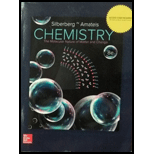
Concept explainers
(a)
Interpretation:
The formula and molecular mass of sodium dichromate are to be determined.
Concept introduction:
The molecular formula of a compound is a representation which suggests the total number of atoms of each element the compound is made of.
The molecular mass of a compound is defined as the sum of the atomic masses of all the atoms present in it.
The general formula to calculate the molecular mass of a compound is,
(a)
Answer to Problem 2.103P
The molecular formula for sodium dichromate is
Explanation of Solution
Dichromate is a polyatomic ion. The formula for the dichromate ion is
Hence the molecular formula for sodium dichromate becomes
The formula to calculate the molecular mass of
Substitute
The molecular formula for sodium dichromate is
(b)
Interpretation:
The formula and molecular mass of ammonium perchlorate are to be determined
Concept introduction:
The molecular formula of a compound is a representation which suggests the total number of atoms of each element the compound is made of.
The molecular mass of a compound is defined as the sum of the atomic masses of all the atoms present in it.
The general formula to calculate the molecular mass of a compound is,
(b)
Answer to Problem 2.103P
The molecular formula for ammonium perchlorate is
Explanation of Solution
Ammonium and perchlorate are polyatomic ions. The formula for the perchlorate ion is
Hence the molecular formula for ammonium perchlorate phosphate becomes
The formula to calculate the molecular mass of
Substitute
The molecular formula for ammonium perchlorate is
(c)
Interpretation:
The formula and molecular mass of magnesium nitrite trihydrate are to be determined
Concept introduction:
The molecular formula of a compound is a representation which suggests the total number of atoms of each element the compound is made of.
The molecular mass of a compound is defined as the sum of the atomic masses of all the atoms present in it.
The general formula to calculate the molecular mass of a compound is,
(c)
Answer to Problem 2.103P
The molecular formula for magnesium nitrite trihydrate is
Explanation of Solution
Nitrite is a polyatomic ion. The formula for the carbonate ion is
Magnesium belongs to the
While naming compounds containing polyatomic ions, when two or more of the same polyatomic ion are present, the ion appears in parentheses. The total number of the polyatomic ion is written as a subscript outside the parentheses.
In magnesium nitrite, two nitrite polyatomic ions associate with one magnesium ion. Hence the molecular formula becomes
Magnesium nitrite trihydrate is the hydrated form of the ionic compound magnesium nitrite. Upon hydration, the molecule of magnesium nitrite bonds with three molecules of water to form a trihydrate molecule. In the molecular formula, the water molecules are shown after a centred dot. Hence the formula for magnesium nitrite trihydrate becomes
The formula to calculate the molecular mass of
Substitute
The molecular formula for magnesium nitrite trihydrate is
Want to see more full solutions like this?
Chapter 2 Solutions
CHEMISTRY >CUSTOM<
- Identify and provide an explanation that distinguishes a qualitative and quantitative chemical analysis. Provide examples.arrow_forwardIdentify and provide an explanation of the operational principles behind a Atomic Absorption Spectrometer (AAS). List the steps involved.arrow_forwardInstructions: Complete the questions in the space provided. Show all your work 1. You are trying to determine the rate law expression for a reaction that you are completing at 25°C. You measure the initial reaction rate and the starting concentrations of the reactions for 4 trials. BrO³¯ (aq) + 5Br¯ (aq) + 6H* (aq) → 3Br₂ (l) + 3H2O (l) Initial rate Trial [BrO3] [H*] [Br] (mol/L) (mol/L) | (mol/L) (mol/L.s) 1 0.10 0.10 0.10 8.0 2 0.20 0.10 0.10 16 3 0.10 0.20 0.10 16 4 0.10 0.10 0.20 32 a. Based on the above data what is the rate law expression? b. Solve for the value of k (make sure to include proper units) 2. The proposed reaction mechanism is as follows: i. ii. BrО¸¯ (aq) + H+ (aq) → HBrO3 (aq) HBrO³ (aq) + H* (aq) → H₂BrO3* (aq) iii. H₂BrO³* (aq) + Br¯ (aq) → Br₂O₂ (aq) + H2O (l) [Fast] [Medium] [Slow] iv. Br₂O₂ (aq) + 4H*(aq) + 4Br(aq) → 3Br₂ (l) + H2O (l) [Fast] Evaluate the validity of this proposed reaction. Justify your answer.arrow_forward
- a. H3C CH3 H, 1.0 equiv. Br2arrow_forwardH3C. H3C CH 3 CH 3 CH3 1. LDA 2. PhSeCl 3. H2O2arrow_forwardPlease predict the products for each of the following reactions: 1.03 2. H₂O NaNH, 1. n-BuLi 2. Mel A H₂ 10 9 0 H2SO4, H₂O HgSO4 Pd or Pt (catalyst) B 9 2 n-BuLi ♡ D2 (deuterium) Lindlar's Catalyst 1. NaNH2 2. EtBr Na, ND3 (deuterium) 2. H₂O2, NaOH 1. (Sia)2BH с Darrow_forward
- in the scope of ontario SCH4U grade 12 course, please show ALL workarrow_forwardIs the chemical reaction CuCl42-(green) + 4H2O <==> Cu(H2O)42+(blue) + 4Cl- exothermic or endothermic?arrow_forwardIf we react tetraethoxypropane with hydrazine, what is the product obtained (explain its formula). State the reason why the corresponding dialdehyde is not used.arrow_forward
 ChemistryChemistryISBN:9781305957404Author:Steven S. Zumdahl, Susan A. Zumdahl, Donald J. DeCostePublisher:Cengage Learning
ChemistryChemistryISBN:9781305957404Author:Steven S. Zumdahl, Susan A. Zumdahl, Donald J. DeCostePublisher:Cengage Learning ChemistryChemistryISBN:9781259911156Author:Raymond Chang Dr., Jason Overby ProfessorPublisher:McGraw-Hill Education
ChemistryChemistryISBN:9781259911156Author:Raymond Chang Dr., Jason Overby ProfessorPublisher:McGraw-Hill Education Principles of Instrumental AnalysisChemistryISBN:9781305577213Author:Douglas A. Skoog, F. James Holler, Stanley R. CrouchPublisher:Cengage Learning
Principles of Instrumental AnalysisChemistryISBN:9781305577213Author:Douglas A. Skoog, F. James Holler, Stanley R. CrouchPublisher:Cengage Learning Organic ChemistryChemistryISBN:9780078021558Author:Janice Gorzynski Smith Dr.Publisher:McGraw-Hill Education
Organic ChemistryChemistryISBN:9780078021558Author:Janice Gorzynski Smith Dr.Publisher:McGraw-Hill Education Chemistry: Principles and ReactionsChemistryISBN:9781305079373Author:William L. Masterton, Cecile N. HurleyPublisher:Cengage Learning
Chemistry: Principles and ReactionsChemistryISBN:9781305079373Author:William L. Masterton, Cecile N. HurleyPublisher:Cengage Learning Elementary Principles of Chemical Processes, Bind...ChemistryISBN:9781118431221Author:Richard M. Felder, Ronald W. Rousseau, Lisa G. BullardPublisher:WILEY
Elementary Principles of Chemical Processes, Bind...ChemistryISBN:9781118431221Author:Richard M. Felder, Ronald W. Rousseau, Lisa G. BullardPublisher:WILEY





